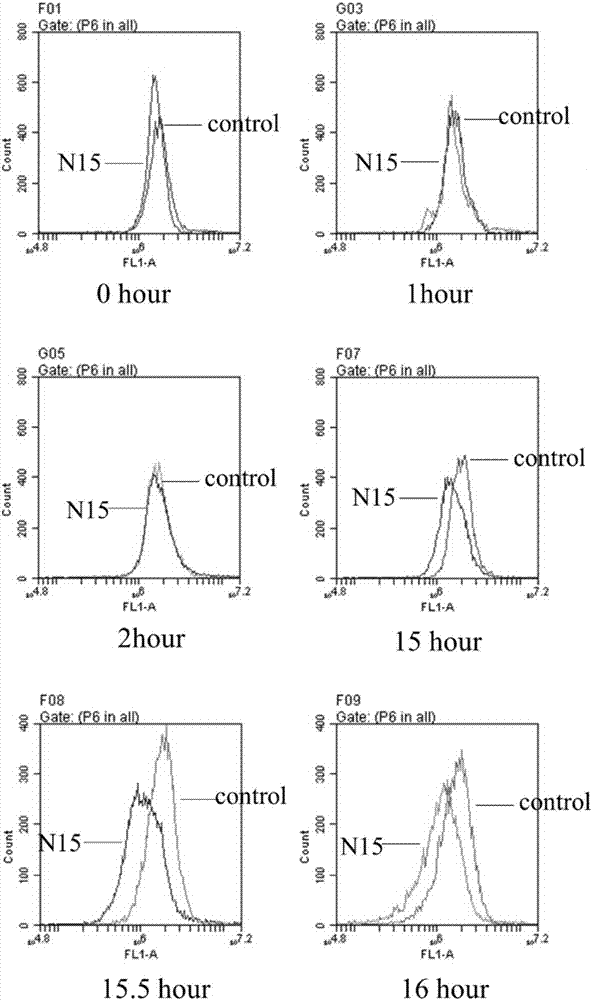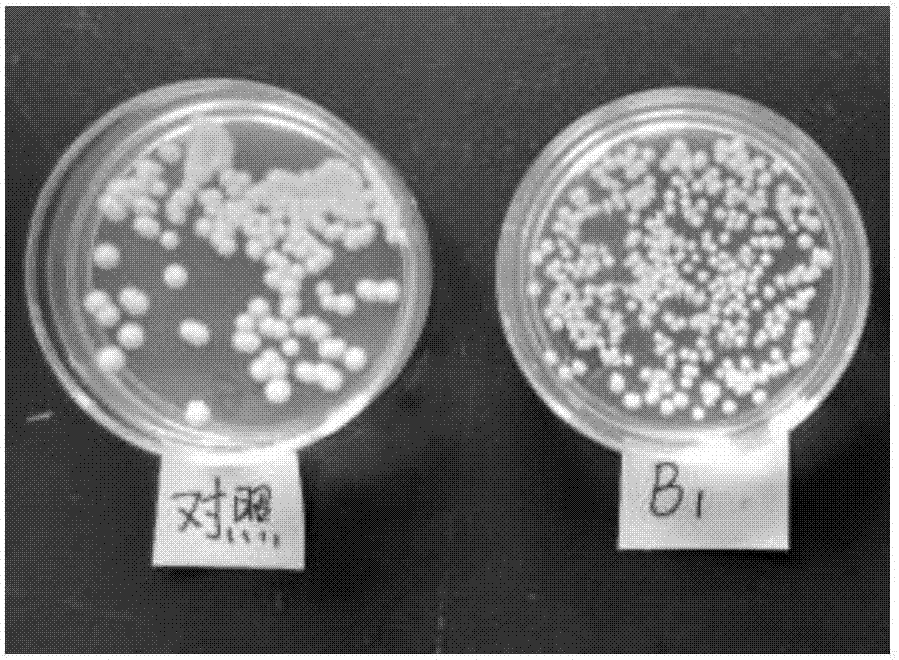Application of N15 polypeptide in preparing fungal inhibitor
An inhibitor, fungal technology, applied in antifungal, drug delivery, pharmaceutical formulations, etc., can solve problems such as economic loss, impact on human health, impact on crop yield, economic animal growth and production, and achieve a clear structure.
- Summary
- Abstract
- Description
- Claims
- Application Information
AI Technical Summary
Problems solved by technology
Method used
Image
Examples
experiment example 1
[0013] Experimental Example 1: N15 has an inhibitory effect on the growth of Saccharomyces cerevisiae
[0014] experimental method:
[0015] A solid plate of YEPD medium was prepared in a petri dish with a diameter of 35 mm, and then N15 was spread on the solid plate (the final concentration of N15 was 2 mg / mL). Take the saturated Saccharomyces cerevisiae cultured overnight, and dilute it to 10 times with physiological saline -4 Concentration, take 50 μL of bacterial solution and add it to a solid plate, spread it evenly with a sterile glass rod, incubate at 30 degrees for 48 hours, observe the experimental results, the results are shown in figure 1 .
[0016] The results showed that white round yeast single colonies were visible on the plate with neat edges and smooth and moist surface. Compared with the single colony of control yeast, the diameter of single colony of yeast (B1) added with N15 polypeptide was significantly smaller, and N15 had an inhibitory effect on the g...
experiment example 2
[0017] Experimental example 2: N15 has an inhibitory effect on the DNA replication of Saccharomyces cerevisiae
[0018] experimental method:
[0019] Prepare YEPD liquid medium, cultivate Saccharomyces cerevisiae, and add N15 to YEPD liquid medium, and set Saccharomyces cerevisiae without N15 polypeptide as a control (control), first use α factor to synchronize the cell cycle of yeast cells, and obtain Synchronized yeast cells. Then add N15 polypeptide (final concentration 500 μg / mL), and sample 2 mL of yeast cells after treatment for 0 hour, 1 hour, 2 hours, 15 hours, 15.5 hours, and 16 hours, and add Sytox-Green dye to stain the yeast cell DNA. The relative content of DNA in Saccharomyces cerevisiae cells was determined by flow cytometry, and the results are shown in figure 2 and Table 1.
[0020] Table 1. N15 to Saccharomyces cerevisiae DNA replication inhibition results control table (relative DNA content of Saccharomyces cerevisiae cells)
[0021]
[0022] As show...
experiment example 3
[0023] Experimental example 3: N15 has inhibitory effect on the growth of Candida albicans
[0024] Weigh 1 mg of N15 peptide dry powder, dissolve it in 1 mL of sterile H2O, prepare a 1 mg / mL mother solution, and then dilute it into N15 solutions with different concentration gradients by doubling dilution method. Add different concentrations of N15 solutions dropwise onto sterile filter paper sheets to make drug-sensitive paper sheets with N15 doses of 100, 50, 20, 10, 5, 2, and 0.5 (unit μg / sheet). Spread the Candida albicans liquid onto the sandburg agar medium plate. Paste different doses of N15 drug-sensitive paper sheets and PBS blank control drug-sensitive paper sheets on the flat plate, place them in an incubator at 28°C for 24 hours, and measure the results. The results are shown in Table 2.
[0025] Table 2. Comparison of the diameter of the inhibition zone produced by the disk method N15 against Candida albicans
[0026]
[0027] As shown in the results, among ...
PUM
 Login to View More
Login to View More Abstract
Description
Claims
Application Information
 Login to View More
Login to View More - R&D
- Intellectual Property
- Life Sciences
- Materials
- Tech Scout
- Unparalleled Data Quality
- Higher Quality Content
- 60% Fewer Hallucinations
Browse by: Latest US Patents, China's latest patents, Technical Efficacy Thesaurus, Application Domain, Technology Topic, Popular Technical Reports.
© 2025 PatSnap. All rights reserved.Legal|Privacy policy|Modern Slavery Act Transparency Statement|Sitemap|About US| Contact US: help@patsnap.com



